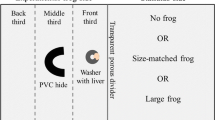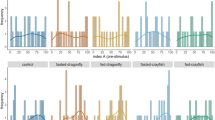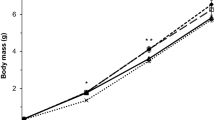Abstract
Animals often halt foraging in the presence of predator cues, an ecological phenomenon known as the foraging/predator avoidance tradeoff. Although some have proposed that anxiety may exist in animals exposed to predator cues, few studies have examined whether such interactions lead to anxiety-like behavior in animals other than laboratory rodents and zebrafish. In this experiment, a foraging/predator avoidance tradeoff task was modified using adult male African clawed frogs (Xenopus laevis) and a looming visual predator stimulus to determine if (1) visual predator cues reduce appetitive behavior, (2) visual predator cues lead to predator avoidance behavior, and (3) if visual predator cues alter the abundance of transcripts in the optic tectum known to be modulated in other brain areas during anxiety. Frogs exposed to the predator stimulus did not reduce their food intake, although sweeping, a foraging behavior, was significantly reduced by the predator stimulus. Predator-exposed animals spent significantly more time stationary and entered the predator zone less compared controls. There were no statistically significant changes in relative transcript abundance of anxiety-related peptides between the groups in the optic tectum. Collectively, this tradeoff task was able to induce discrete avoidance and appetitive behaviors that are similar to anxiety-like behaviors observed in other predator avoidance models; however, the effects of visual threats on feeding and anxiety-related transcript abundance requires further study.
Significance statement
Halting foraging activities to increase vigilance and engage avoidance behaviors has been proposed to play an adaptive role in survival of predator encounters in a number of animal species. Some have proposed that anxiety evolved as a state associated with the engagement of avoidance and antipredator behavior. However, few studies have examined whether such foraging/predator avoidance tradeoffs result in anxiety-like behavior in animals other than rodents. We developed a foraging/predator avoidance tradeoff task in an aquatic frog species to determine if the sight of a looming visual threat interferes with feeding and causes anxiety-like behavior in an amphibian. Our data suggest that some, but not other (feeding, for example), behavioral aspects of foraging/predator avoidance tradeoffs mimic anxiety-like behavior when a visual threat is present. These data contribute to a growing body of literature indicating that anxiety may be an adaptive response to predator threats in non-mammalian species.




Similar content being viewed by others
Data availability
Data are available in the “Supplementary information.”
References
Albert PR, Fiori LM (2014) Transcriptional dys-regulation in anxiety and major depression: 5-HT1A gene promoter architecture as a therapeutic opportunity. Curr Pharm Design 20:3738–3750
Almada RC, Coimbra NC (2015) Recruitment of striatonigral disinhibitory and nigrotectal inhibitory GABAergic pathways during the organization of defensive behavior by mice in a dangerous environment with the venomous snake Bothrops alternatus (Reptilia, Viperidae). Synapse 69:299–313
Avila VL, Frye PG (1978) Feeding-behavior of African clawed frog (Xenopus-laevis daudin) - (amphibia, anura, pipidae) - effect of prey type. J Herpetol 12:391–396
Azevedo H, Ferreira M, Mascarello A, Osten P, Guimaraes CRW (2020) The serotonergic and alpha-1 adrenergic receptor modulator ACH-000029 ameliorates anxiety-like behavior in a post-traumatic stress disorder model. Neuropharmacology 164:107912
Baek J, Lee S, Cho T et al (2019) Neural circuits underlying a psychotherapeutic regimen for fear disorders. Nature 566:339–343
Băncilă RI, Plaiasu R, Stanescu F, Schmidt BR, Nae I, Denoel M (2021) Food level and light conditions affect the antipredator behavior in larvae of a stream-breeding amphibian. Behav Ecol Sociobiol 75:36
Beck AT, Brown G, Epstein N, Steer RA (1988) An inventory for measuring clinical anxiety - psychometric properties. J Consult Clin Psychol 56:893–897
Belzung C, Griebel G (2001) Measuring normal and pathological anxiety-like behaviour in mice: a review. Behav Brain Res 125:141–149
Bencan Z, Sledge D, Levin ED (2009) Buspirone, chlordiazepoxide and diazepam effects in a zebrafish model of anxiety. Pharmacol Biochem Behav 94:75–80
Blanchard RJ, Blanchard DC, Rodgers J, Weiss SM (1990) The characterization and modeling of antipredator defensive behavior. Neurosci Biobehav Rev 14:463–472
Blaser RE, Rosemberg DB (2012) Measures of anxiety in Zebrafish (Danio rerio): dissociation of black/white preference and novel tank test. PLoS ONE 7:e36931
Blumstein D, Daniel JC (2007) Quantifying Behavior the JWatcher Way. Sinauer Associates Inc, Sunderland, MA
Boorse GC, Denver RJ (2006) Widespread tissue distribution and diverse functions of corticotropin-releasing factor and related peptides. Gen Comp Endocrinol 146:9–18
Bourin M (2015) Animal models for screening anxiolytic-like drugs: a perspective. Dialogues Clin Neurosci 17:295–303
Campos AC, Fogaca MV, Aguiar DC, Guimaraes FS (2013) Animal models of anxiety disorders and stress. Braz J Psychiat 35:S101–S111
Carr JA, Zhang B, Li WJ, Gao MM, Garcia C, Lustgarten J, Wages M, Smith EE (2013) An intrinsic CRF signaling system within the optic tectum. Gen Comp Endocrinol 188:204–211
Cheng BH, McCarthy JM (2018) Understanding the dark and bright sides of anxiety: a theory of workplace anxiety. J Appl Psychol 103:537–560
Cianca V, Bartolini T, Porfiri M, Macri S (2013) A robotics-based behavioral paradigm to measure anxiety-related responses in Zebrafish. PLoS ONE 8:e69661. https://doi.org/10.1371/journal.pone.0069661
Claas B, Dean J (2006) Prey-capture in the African clawed toad (Xenopus laevis): comparison of turning to visual and lateral line stimuli. J Comp Physiol A 192:1021–1036
Coleman RB, Aguirre K, Spiegel HP, Pecos C, Carr JA, Harris BN (2019) The plus maze and scototaxis test are not valid behavioral assays for anxiety assessment in the South African clawed frog. J Comp Physiol A 205:567–582
Cornwell BR, Mueller SC, Kaplan R, Grillon C, Ernst M (2012) Anxiety, a benefit and detriment to cognition: Behavioral and magnetoencephalographic evidence from a mixed-saccade task. Brain Cognition 78:257–267
Cryan JF, Holmes A (2005) The ascent of mouse: advances in modelling human depression and anxiety. Nat Rev Drug Discov 4:775–790
Cryan JF, Sweeney FF (2011) The age of anxiety: role of animal models of anxiolytic action in drug discovery. Brit J Pharmacol 164:1129–1161
de Abreu MS, Maximino C, Banha F, Anastácio PM, Demin KA, Kalueff AV, Soares MC (2020) Emotional behavior in aquatic organisms? Lessons from crayfish and zebrafish. J Neurosci Res 98:764–779
de Almeida LP, Ramos PL, Pandossio JE, Landeira-Fernandez J, Zangrossi H, Nogueira RL (2006) Prior electrical stimulation of dorsal periaqueductal grey matter or deep layers of the superior colliculus sensitizes rats to anxiety-like behaviors in the elevated T-maze test. Behav Brain Res 170:175–181
Dong W, Lee RH, Xu H, Yang S, Pratt KG, Cao V, Song YK, Nurmikko A, Aizenman CD (2009) Visual avoidance in Xenopus tadpoles is correlated with the maturation of visual responses in the optic tectum. J Neurophys 101:803–815
Duggan PE, Prater C, Carr JA, Harris BN (2016) Predator presence decreases food consumption in juvenile Xenopus laevis. Behav Ecol Sociobiol 70:2005–2015
Forcelli PA, DesJardin JT, West EA, Holmes AL, Elorette C, Wellman LL, Malkova L (2016) Amygdala selectively modulates defensive responses evoked from the superior colliculus in non-human primates. Soc Cogn Affect Neurosci 11:2009–2019
Freeman D, Waller H, Harpur-Lewis RA et al (2015) Urbanicity, persecutory delusions, and clinical intervention: the development of a brief CBT Module for helping patients with persecutory delusions enter social urban environments. Behav Cogn Psychoth 43:42–51
Gray LA, Oreilly JC, Nishikawa KC (1997) Evolution of forelimb movement patterns for prey manipulation in anurans. J Exp Zool 277:417–424
Green SL (2009) The Laboratory Xenopus sp., 1st edn. CRC Press, Boca Raton, FL
Gupta D, Radhakrishnan M, Kurhe Y (2014) Insulin reverses anxiety-like behavior evoked by streptozotocin-induced diabetes in mice. Metab Brain Dis 29:737–746
Hamilton M (1959) The assessment of anxiety states by rating. Brit J Med Psychol 32:50–55
Harris BN (2020) Stress hypothesis overload: 131 hypotheses exploring the role of stress in tradeoffs, transitions, and health. Gen Comp Endocrinol 288:113355. https://doi.org/10.1016/j.ygcen.2019.113355
Harris BN, Carr JA (2016) The role of the hypothalamus-pituitary-adrenal/interrenal axis in mediating predator-avoidance trade-offs. Gen Comp Endocrinol 230:110–142
Huang L, Yuan TF, Tan MJ et al (2017) A retinoraphe projection regulates serotonergic activity and looming-evoked defensive behaviour. Nat Commun 8:14908
Islam R, Prater CM, Harris BN, Carr JA (2019) Neuroendocrine modulation of predator avoidance/prey capture tradeoffs: role of tectal NPY2R receptors. Gen Comp Endocrinol 282:113214. https://doi.org/10.1016/j.ygcen.2019.113214
Javanmard M, Shlik J, Kennedy SH, Vaccarino FJ, Houle S, Bradwejn J (1999) Neuroanatomic correlates of CCK-4-induced panic attacks in healthy humans: a comparison of two time points. Biol Psychiat 45:872–882
Kandel ER (1983) From metapsychology to molecular-biology - explorations into the nature of anxiety. Am J Psychiat 140:1277–1293
Kaye WH, Bulik CM, Thornton L, Barbarich N, Masters K, Price Foundation Collaborative Group (2004) Comorbidity of anxiety disorders with anorexia and bulimia nervosa. Am J Psychiat 161:2215-2221
Keers R, Pedroso I, Breen G, Aitchison KJ, Nolan PM, Cichon S, Nothen MM, Rietschel M, Schalkwyk LC, Fernandes C (2012) Reduced anxiety and depression-like behaviours in the circadian period mutant mouse afterhours. PLoS ONE 7:e38263. https://doi.org/10.1371/journal.pone.0038263
Kelleher SR, Silla AJ, Byrne PG (2018) Animal personality and behavioral syndromes in amphibians: a review of the evidence, experimental approaches, and implications for conservation. Behav Ecol Sociobiol 72:79
Kessler MS, Debilly S, Schoppenthau S, Bielser T, Bruns A, Kunnecke B, von Kienlin M, Wettstein JG, Moreau JL, Risterucci C (2012) fMRI fingerprint of unconditioned fear-like behavior in rats exposed to trimethylthiazoline. Eur Neuropsychopharmacol 22:222–230
Kopij G (1996) Breeding and feeding ecology of the Reed Cormorant, Phalacrocorax africanus, in the Free State. S Afr Acta Ornithol 31:89–99
Kopij G (1998) Diet of Whitebreasted Cormorant Phalacrocorax carbo nestlings in the south-eastern Free State, South Africa. S Afr J Wildl Res 28:100–102
Krohne HW (2001) Stress and coping theories. In: Smelser NJ, Baltes PB (eds) International Encyclopedia of the Social and Behavioral Sciences. Elsevier, Amsterdam, pp 15163–15170
Kysil EV, Meshalkina DA, Frick EE et al (2017) Comparative analyses of Zebrafish anxiety-like behavior using conflict-based novelty tests. Zebrafish 14:197–208
Lang PJ, Bradley MM, Cuthbert BN (1998) Emotion, motivation, and anxiety: brain mechanisms and psychophysiology. Biol Psychiat 44:1248–1263
Lea AJ, Blumstein DT (2011) Age and sex influence marmot antipredator behavior during periods of heightened risk. Behav Ecol Sociobiol 65:1525–1533
Lischinsky JE, Lin DY (2019) Looming danger: Unraveling the circuitry for predator threats. Trends Neurosci 42:841–842
Liu J, Garza JC, Truong HV, Henschel J, Zhang W, Lu XY (2007) The melanocortinergic pathway is rapidly recruited by emotional stress and contributes to stress-induced anorexia and anxiety-like behavior. Endocrinology 148:5531–5540
Liu YJ, Wang Q, Li B (2011) Neuronal responses to looming objects in the superior colliculus of the cat. Brain Behav Evol 77:193–205
Loveridge A (1953) Zoological results of a fifth expedition to East Africa. IV Amphibians from Nyasaland and Tete. Bull Mus Comp Zool 110:325–406
McFadyen J, Mattingley JB, Garrido MI (2019) An afferent white matter pathway from the pulvinar to the amygdala facilitates fear recognition. Elife 8:e40766. https://doi.org/10.7554/eLife.40766
Merali Z, Levac C, Anisman H (2003a) Validation of a simple, ethologically relevant paradigm for assessing anxiety in mice. Biol Psychiat 54:552–565
Merali Z, Michaud D, McIntosh J, Kent P, Anisman H (2003b) Differential involvement of amygdaloid CRH system(s) in the salience and valence of the stimuli. Prog Neuro-Psychopharmacol Biol Psychiat 27:1201–1212
Mohammad F, Ho J, Woo JH, Lim CL, Poon DJJ, Lamba B, Claridge-Chang A (2016) Concordance and incongruence in preclinical anxiety models: systematic review and meta-analyses. Neurosci Biobehav Rev 68:504–529
Morris DW, Dupuch A, Moses M, Busniuk K, Otterman H (2019) Differences in behavior help to explain lemming coexistence. J Mammal 100:1211–1220
Muller-Gass A, Porath A, Anisman H, Merali Z (2000) Novelty-induced delay in snack approach: a robust and rapid naturalistic model for anxiety assessment. Soc Neurosci Abstr 30(659):2
Muthuraju S, Talbot T, Brandao ML (2016) Dopamine D-2 receptors regulate unconditioned fear in deep layers of the superior colliculus and dorsal periaqueductal gray. Behav Brain Res 297:116–123
Narayan EJ, Cockrem JF, Hero JM (2013) Sight of a predator induces a corticosterone stress response and generates fear in an amphibian. PLoS ONE 8:e73564. https://doi.org/10.1371/journal.pone.0073564
Perusini JN, Fanselow MS (2015) Neurobehavioral perspectives on the distinction between fear and anxiety. Learn Mem 22:417–425
Pineles SL, Mostoufi SM, Ready CB, Street AE, Griffin MG, Resick PA (2011) trauma reactivity, avoidant coping, and PTSD symptoms: a moderating relationship? J Abnorm Psychol 120:240–246
Prater CM, Garcia C, McGuire LP, Carr JA (2018a) Tectal corticotropin-releasing factor (CRF) neurons respond to fasting and a reactive stressor in the African Clawed Frog, Xenopus laevis. Gen Comp Endocrinol 258:91–98
Prater CM, Harris BN, Carr JA (2018b) Tectal CRFR1 receptors modulate food intake and feeding behavior in the South African clawed frog Xenopus laevis. Horm Behav 105:86–94
Prater CM, Harris BN, Carr JA (2020) Tectal CRFR1 receptor involvement in avoidance and approach behaviors in the South African clawed frog. Xenopus Laevis. Horm Behav 120:104707. https://doi.org/10.1016/j.yhbeh.2020.104707
Rodgers RJ, Cao BJ, Dalvi A, Holmes A (1997) Animal models of anxiety: an ethological perspective. Brazil J Med Biol Res 30:289–304
Samuels BA, Mendez-David I, Faye C, David SA, Pierz KA, Gardier AM, Hen R, David DJ (2016) Serotonin 1A and serotonin 4 receptors: essential mediators of the neurogenic and behavioral actions of antidepressants. Neuroscientist 22:26–45
Sayin U, Sutula TP, Stafstrom CE (2004) Seizures in the developing brain cause adverse long-term effects on spatial learning and anxiety. Epilepsia 45:1539–1548
Schiwitz NC, Schalk CM, Saenz D (2020) Activity level-predation risk tradeoff in a tadpole guild: Implications for community organization along the hydroperiod gradient. Am Midl Nat 183:223–232
Serova LI, Laukova M, Alaluf LG, Pucillo L, Sabban EL (2014) Intranasal neuropeptide Y reverses anxiety and depressive-like behavior impaired by single prolonged stress PTSD model. Eur Neuropsychopharmacol 24:142–147
Shen MY, Perreault ML, Bambico FR, Jones-Tabah J, Cheung M, Fan T, Nobrega JN, George SR (2015) Rapid anti-depressant and anxiolytic actions following dopamine D1–D2 receptor heteromer inactivation. Eur Neuropsychopharmacol 25:2437–2448
Shi YB, Liang VCT (1994) Cloning and characterization of the ribosomal protein L8 gene from Xenopus laevis. Biochim Biophys Acta Gene Regul Mech 1217:227–228
Smith KS, Engin E, Meloni EG, Rudolph U (2012) Benzodiazepine-induced anxiolysis and reduction of conditioned fear are mediated by distinct GABA(A) receptor subtypes in mice. Neuropharmacology 63:250–258
Steimer T (2002) The biology of fear- and anxiety-related behaviors. Dialogues Clin Neurosci 4:231–249
Steuwe C, Daniels JK, Frewen PA, Densmore M, Theberge J, Lanius RA (2015) Effect of direct eye contact in women with PTSD related to interpersonal trauma: psychophysiological interaction analysis of connectivity of an innate alarm system. Psychiat Res-Neuroim 232:162–167
Stewart AM, Braubach O, Spitsbergen J, Gerlai R, Kalueffl AV (2014) Zebrafish models for translational neuroscience research: from tank to bedside. Trends Neurosci 37:264–278
Tafet GE, Nemeroff CB (2020) Pharmacological treatment of anxiety disorders: the role of the HPA axis. Front Psychiat 11:443
Takahara T, Kohmatsu Y, Maruyama A, Doi H, Yamanaka H, Yamaoka R (2012) Inducible defense behavior of an anuran tadpole: cue-detection range and cue types used against predator. Behav Ecol 23:863–868
Tomczak M, Tomczak E (2014) The need to report effect size estimates revisited. An overview of some recommended measures of effect size. Trend Sport Sci 21:19–25
Videlier M, Bonneaud C, Cornette R, Herrel A (2014) Exploration syndromes in the frog Xenopus (Silurana) tropicalis: correlations with morphology and performance? J Zool 294:206–213
Videlier M, Cornette R, Bonneaud C, Herrel A (2015) Sexual differences in exploration behavior in Xenopus tropicalis? J Exp Biol 218:1733–1739
Wu LQ, Niu YQ, Yang J, Wang SR (2005) Tectal neurons signal impending collision of looming objects in the pigeon. Eur J Neurosci 22:2325–2331
Zhou Z, Liu XM, Chen SP et al (2019) A VTA GABAergic neural circuit mediates visually evoked innate defensive responses. Neuron 103:473–488
Acknowledgements
We thank the Texas Tech University Department of Biological Sciences and the Texas Tech University Association of Biologists for funds to NMM. We also acknowledge Drs. Karina Alvina, Lauren Gollahon, Naima Moustaid-Moussa, and Ernest Smith for assistance with experimental design and Marcos Arciniega and Hailey Luckie for help with behavior analysis. Finally, we thank the anonymous reviewers and editorial team at BES for their valuable contributions. This work was completed in partial fulfillment of the requirements for a doctoral degree in the Department of Biological Sciences at Texas Tech University (NMM).
Funding
Funding was provided by the National Science Foundation IOS #1,656,734, Texas Tech University Department of Biological Sciences, and a Graduate Student Research Support Award provided by Texas Tech University Graduate School.
Author information
Authors and Affiliations
Contributions
Both authors contributed to the design of the study. Material preparation, data collection, and analysis were performed by NMM. Writing and editing was done by NMM with guidance and editing from JAC. Guidance, resources, and supervision on this project was provided by JAC.
Corresponding author
Ethics declarations
Ethics approval
All procedures involving animals were approved by the Texas Tech Animal Care and Use Committee (protocol number 18089–11) and follow Association for Assessment and Accreditation of Laboratory Animal Care International (AAALAC International) guidelines including the Eighth Edition of the Guide for the Care and Use of Laboratory Animals (NRC 2011) and the European Convention for the Protection of Vertebrate Animals Used for Experimental and Other Scientific Purposes, Council of Europe (ETS 123).
Conflict of interest
The authors declare no competing interests.
Additional information
Communicated by A. Taylor Baugh
Publisher's note
Springer Nature remains neutral with regard to jurisdictional claims in published maps and institutional affiliations.
Supplementary Information
Below is the link to the electronic supplementary material.
Rights and permissions
Springer Nature or its licensor holds exclusive rights to this article under a publishing agreement with the author(s) or other rightsholder(s); author self-archiving of the accepted manuscript version of this article is solely governed by the terms of such publishing agreement and applicable law.
About this article
Cite this article
Menon, N.M., Carr, J.A. Anxiety-like behavior and tectal gene expression in a foraging/predator avoidance tradeoff task using adult African clawed frogs Xenopus laevis. Behav Ecol Sociobiol 76, 115 (2022). https://doi.org/10.1007/s00265-022-03219-0
Received:
Revised:
Accepted:
Published:
DOI: https://doi.org/10.1007/s00265-022-03219-0




